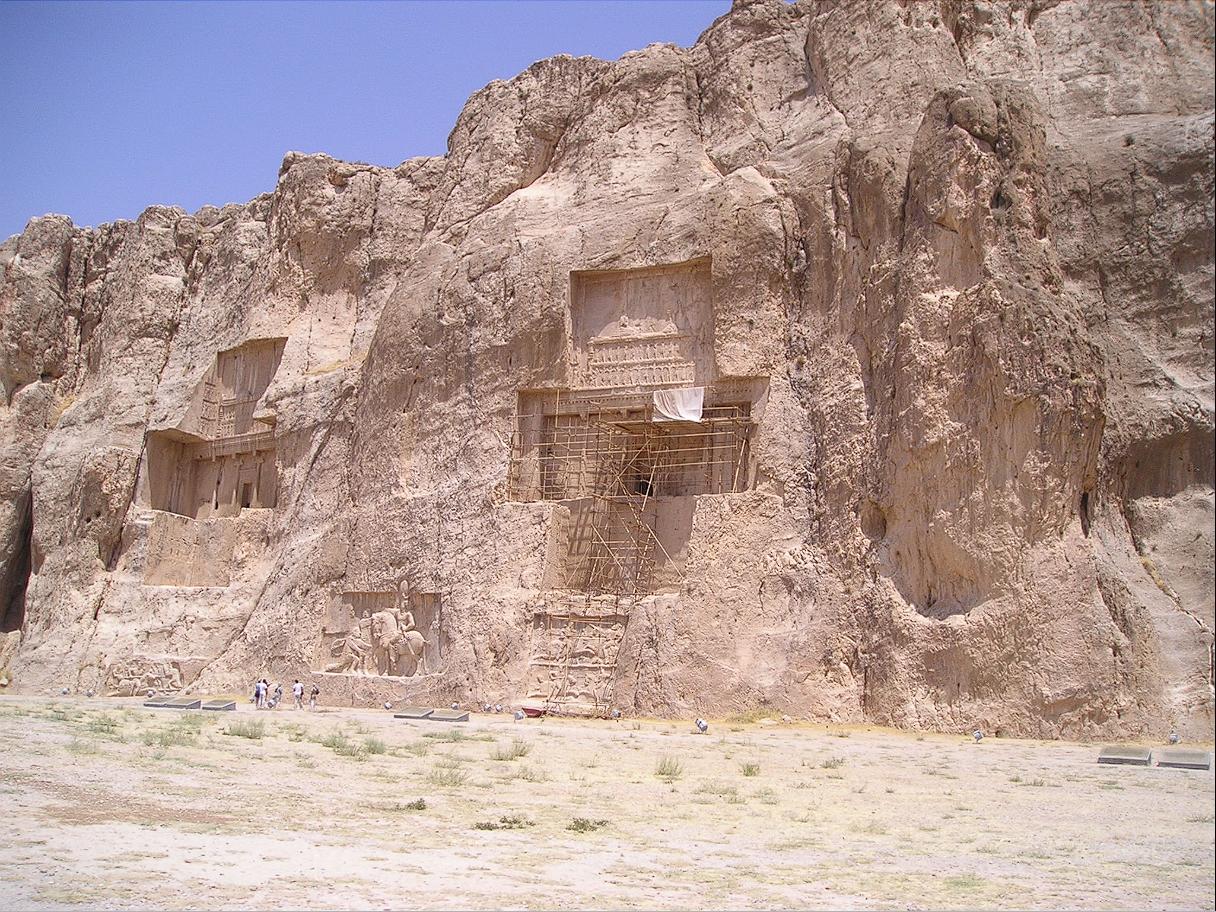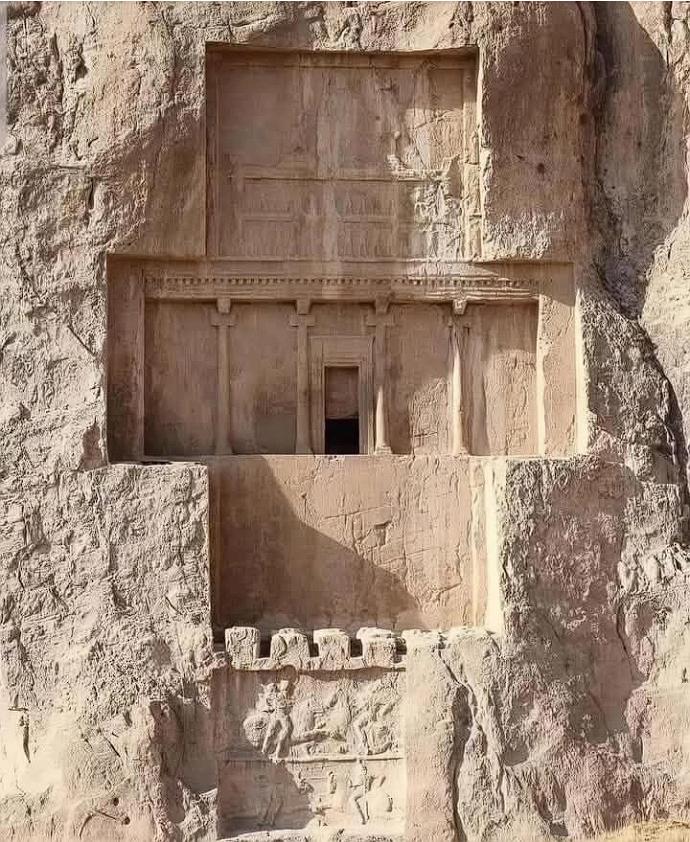The Tomb of Darius I, also known as Darius the Great, stands majestically at Naqsh-e Rustam, Iran, a powerful symbol of the Persian Empire’s zenith. This monumental tomb, carved into the cliffs, serves as a lasting testament to one of Persia’s most influential rulers, whose reign shaped the ancient world.
The Majesty of Naqsh-e Rustam
Naqsh-e Rustam, the site of Darius I’s tomb, is a significant historical location that reflects the grandeur and power of the Persian Empire.
Royal Necropolis
Naqsh-e Rustam served as a royal necropolis, housing the tombs of several Persian kings, including Darius I, Xerxes I, Artaxerxes, and Darius II.

- Cliff Tombs:
- The tombs, carved high into the cliffs, were designed to be both imposing and secure, reflecting the power and authority of the Persian rulers.
- They were carved into cliffs.
- Symbol of Power:
- The location and design of the tombs symbolized the divine right of the Persian kings and their connection to the land.
- They symbolized royal power.
- Historical Significance:
- Naqsh-e Rustam’s historical significance lies in its role as a burial site for Persian royalty, offering insights into their beliefs and practices.
- It has historical significance.
Darius I: The Great King
Darius I, who reigned from 522 to 486 BC, was one of the most powerful rulers of the Persian Empire, expanding its borders and solidifying its influence.
- Peak of the Persian Empire:
- Darius I oversaw the Persian Empire at its peak, extending its dominion from India to Egypt and encompassing vast territories.
- He ruled at the empire’s peak.
- Expansion and Influence:
- His reign was marked by significant expansion and consolidation, making him a key figure in ancient history.
- He expanded the empire.
- Administrative Reforms:
- Darius I implemented administrative reforms, including the division of the empire into satrapies, which helped to maintain stability and control.
- He made administrative reforms.
Looting in Antiquity
Despite their grand design, the tombs at Naqsh-e Rustam were looted in antiquity, leaving behind only their monumental presence and inscriptions.

- Loss of Treasures:
- The looting of the tombs resulted in the loss of valuable artifacts and treasures, depriving us of a more complete understanding of Persian burial practices.
- The tombs were looted.
- Enduring Presence:
- Despite the looting, the tombs’ monumental presence and architectural grandeur continue to inspire awe and wonder.
- The tombs are still impressive.
- Inscriptions as Historical Records:
- The inscriptions on the tombs provide valuable historical records, offering insights into the reigns and beliefs of the Persian kings.
- The inscriptions are historical records.
The Tomb of Darius I: A Legacy in Stone
The Tomb of Darius I stands as a testament to his power and the grandeur of the Persian Empire, with its intricate carvings and inscriptions.
Divine Right to Rule
The facade of Darius’s tomb bears an inscription that speaks of his divine right to rule, granted by Ahuramazda, the supreme deity in Zoroastrianism.
- Ahuramazda’s Grant:
- The inscription emphasizes that Darius’s authority was divinely sanctioned, reinforcing his legitimacy as “King of Kings.”
- His authority was divine.
- Religious Legitimacy:
- The connection to Ahuramazda provided religious legitimacy to Darius’s rule, aligning his power with the divine order.
- He had religious legitimacy.
- Symbol of Authority:
- The inscription served as a powerful symbol of authority, reminding both subjects and rivals of Darius’s divine mandate.
- The inscription was a symbol of authority.
Vast Empire
The inscription proclaims Darius’s dominion over a vast empire, stretching from India to Egypt and encompassing diverse lands and cultures.
- Territorial Extent:
- The inscription highlights the sheer scale of the Persian Empire, showcasing its vast territorial extent and diverse populations.
- The empire was vast.
- Lands and Cultures:
- The mention of lands such as Media, Babylon, Lydia, and Greece underscores the empire’s multicultural nature and its influence across different regions.
- The empire was multicultural.
- “King of Kings” Title:
- The title “King of Kings” reflects Darius’s supreme authority over the empire and its various rulers and peoples.
- He was “King of Kings”.
Architectural Grandeur
The architectural design of Darius’s tomb, with its intricate carvings and monumental facade, reflects the grandeur and sophistication of Persian art and architecture.

- Carved Reliefs:
- The tomb features intricately carved reliefs depicting scenes of royal processions and symbolic imagery, showcasing Persian artistic skill.
- It has carved reliefs.
- Monumental Facade:
- The imposing facade, carved into the cliff face, creates a powerful visual impact, reflecting the majesty of the Persian Empire.
- It has an impressive facade.
- Symbolic Imagery:
- The symbolic imagery on the tomb, including representations of Ahuramazda and royal symbols, conveys the spiritual and political messages of the Persian rulers.
- It has symbolic imagery.
The Enduring Legacy of Darius I
The Tomb of Darius I at Naqsh-e Rustam continues to inspire awe and wonder, offering a glimpse into the grandeur of ancient Persia and the legacy of its greatest rulers.
Historical Significance
The tomb serves as a valuable historical site, providing insights into the political, religious, and artistic traditions of the Persian Empire.
- Persian Empire’s Legacy:
- The tomb contributes to our understanding of the Persian Empire’s legacy, highlighting its cultural achievements and historical significance.
- It contributes to the empire’s legacy.
- Ancient Persian Culture:
- The site offers a glimpse into the ancient Persian culture, including their beliefs, rituals, and artistic expressions.
- It shows ancient Persian culture.
- Archaeological Research:
- The tomb and its inscriptions provide valuable material for archaeological research, contributing to our ongoing efforts to understand ancient Persia.
- It is used for archaeological research.
Cultural Heritage
The Tomb of Darius I is a significant cultural heritage site, attracting visitors and scholars from around the world.
- Tourism and Education:
- The site attracts tourists and scholars, promoting awareness of Persian history and culture.
- It is a tourist destination.
- Preservation Efforts:
- Preservation efforts are crucial for safeguarding the tomb and its inscriptions, ensuring that its historical and cultural value is maintained.
- It is preserved.
- Global Interest:
- The tomb’s global interest reflects the enduring fascination with ancient Persia and its influential rulers.
- It has global interest.
Symbol of Grandeur
The Tomb of Darius I stands as a powerful symbol of the grandeur and power of the Persian Empire, reminding us of its lasting impact on the ancient world.
- Awe-Inspiring Site:
- The tomb’s monumental presence and historical significance make it an awe-inspiring site, evoking a sense of wonder and respect.
- It is awe-inspiring.
- Lasting Impact:
- The legacy of Darius I and his empire continues to resonate, highlighting the enduring influence of ancient Persia on world history.
- It shows lasting impact.
- Historical Connection:
- The tomb provides a tangible connection to the past, reminding us of the lives and legacies of those who shaped ancient civilizations.
- It provides a historical connection.
The Tomb of Darius I at Naqsh-e Rustam stands as a powerful and enduring symbol of the Persian Empire’s grandeur and influence. Its intricate carvings, monumental presence, and historical significance continue to captivate and educate, offering a glimpse into one of the ancient world’s most influential civilizations.

CÁC TIN KHÁC
Mary Walton: The Forgotten Inventor Who Helped Clean Up America’s Cities
Tomb of Queen Nefertari in the Valley of the Queens, Egypt
Discover the Hypostyle Hall of the Temple of Hathor at Dendera
Venus de Losange: Unveiling the Mystery of a 20,000-Year-Old Paleolithic Icon